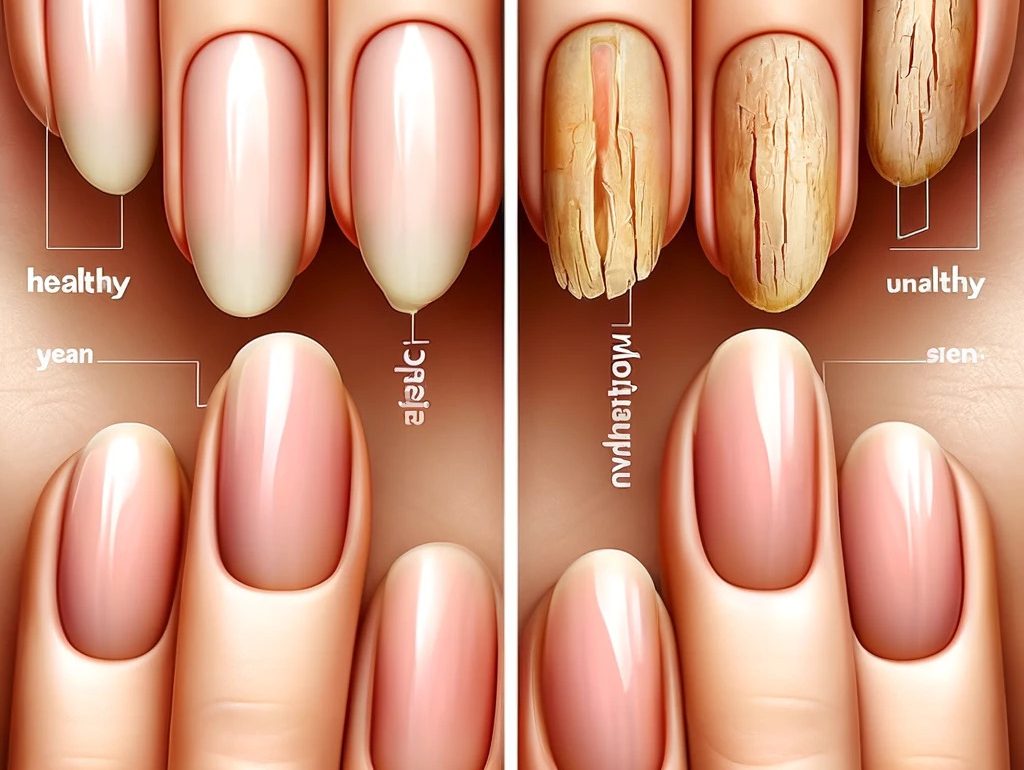Nails can tell us a lot about our health, from the colors to textures and even the thickness. Taking a few minutes to observe your nails might offer more insights than you’d expect! Healthy nails often look smooth, strong, and have a consistent color, while unhealthy nails might show signs of damage or deficiencies. Knowing the differences can be the key to understanding and improving your nail health, so let’s dive in and explore!
1. Signs of Healthy Nails: What to Look For
Healthy nails are more than just a beauty bonus—they’re a window to your overall well-being. Typically, healthy nails appear smooth, pinkish, and have a slight natural sheen. The pink color reflects healthy blood flow underneath, while the lack of ridges and cracks signifies a well-maintained nail structure. In a nail health chart, these are the marks of nails that are strong and balanced. If your nails check off these qualities, you’re likely on the right track!
Another sign of healthy nails is their resilience. If you find that your nails don’t easily bend or break with minor bumps, it’s a good indicator they’re strong. Maintaining this strength can often be as simple as keeping them moisturized and avoiding exposure to harsh chemicals. Regular hydration helps maintain that nice, flexible quality that keeps nails from becoming brittle or dry.
2. Signs of Unhealthy Nails and What They Mean
On the flip side, unhealthy nails have some clear indicators that should catch your attention. One common sign is discoloration, such as yellowing or spots, which may be a sign of fungal infections or vitamin deficiency. If you notice ridges—especially deep vertical or horizontal lines—it might indicate a lack of essential nutrients, or even be a response to stress.
Sometimes, unhealthy nails can become thin and split, which may point to a lack of calcium or other vital minerals. If you’re seeing signs like peeling or extreme brittleness, it could mean your nails are crying out for more moisture or protein. Keeping an eye on these nail health signs and acting quickly can prevent further damage. For example, including biotin-rich foods or vitamin supplements in your diet can make a difference in nail resilience over time.
3. Vitamin Deficiency and How It Shows in Your Nails
Our nails are often the first to show signs of vitamin deficiency, making them a useful early warning system. For instance, white spots can sometimes mean a zinc deficiency, while brittle, weak nails are often a sign that you may need more iron. Spoon-shaped nails, which curve inward, can indicate anemia or a lack of oxygen, both of which can often be improved with more iron-rich foods or supplements.
Similarly, a lack of B-complex vitamins can result in dry, ridged nails. The good news? You can work on your nail health naturally. Including a variety of fruits, vegetables, and lean proteins in your diet can supply the essential vitamins needed to maintain strong, healthy nails. And don’t forget: staying hydrated is a natural and essential way to support nail health from the inside out!
4. Natural Tips for Getting Healthier Nails
If you’re looking to improve your nail health, there are plenty of simple, natural remedies to try at home. One of the easiest ways is through regular moisturizing. Use a good hand cream that nourishes the nails and cuticles. Oils like coconut, olive, or almond can work wonders to keep nails and cuticles hydrated. Apply a small amount at night to help lock in moisture and support nail strength.
Adding more nail-friendly nutrients to your diet is another excellent strategy. Foods rich in biotin, like eggs and nuts, can help strengthen nails, while leafy greens and fish are great for providing a balance of vitamins and minerals. Another home remedy is to soak your nails in a mixture of warm water and apple cider vinegar. This can naturally balance your nails’ pH levels, reduce brittleness, and even help prevent infections.
5. Keeping Your Nails Strong and Healthy with Small Lifestyle Changes
Keeping nails strong doesn’t always require a dramatic overhaul—small changes can go a long way. For example, wearing gloves when cleaning or handling harsh chemicals can prevent damage and dryness. Filing your nails regularly in one direction, rather than back and forth, can help avoid splits and cracks. Even limiting your exposure to acetone-based nail polish removers can help protect your nails’ natural strength.
Taking these steps not only promotes healthy nails but also reinforces the importance of nail care as a key part of your self-care routine. Our nails may seem small, but they play a big role in our appearance and confidence. Following these simple tips will ensure you maintain vibrant, resilient nails for the long haul.
Final Thoughts: Why Nail Care is Worth Your Time
Taking care of your nails is more than a beauty habit—it’s about fostering healthy habits that reflect on your overall health. By understanding the signs of healthy vs. unhealthy nails, you can take proactive steps to support stronger, shinier nails that don’t just look good but feel strong too. Remember, your nails are a part of you, and giving them the care they need will have you feeling more put-together, confident, and healthy. So go ahead, give those nails the attention they deserve!

